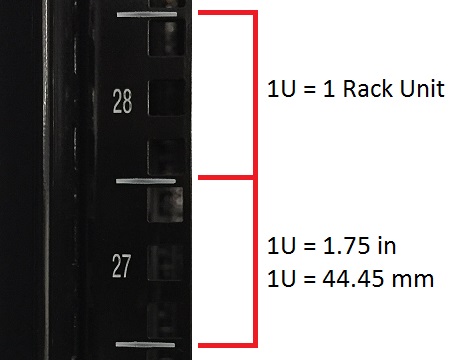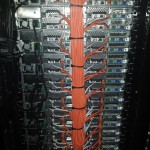Wondering what that RU means on the side of the server box? Trying to figure out if you have enough space for the IT department? This primer on rack units will help you understand what a rack unit is and what you need to know about dimensions, capabilities and how to use rack units to your advantage.

1U spacers in a cabinet
Letters, Numbers, or Both?

1U measurements
When you see the word “rack unit,” two things probably come to mind: a metal shelving unit and units of measurement. You’re on the right track, because both of these are correct. While a rack unit (RU or simply U) is technically the term for a unit of measurement, it only pertains to the height of the space (and the equipment) on a shelving rack designed for electronic equipment.
The term is a standard measurement that comes from the Electronic Industries Alliance. It’s used on a variety of rack mount electronic equipment used for audio/visual, computing and information technology purposes. Servers and network switches are the most common devices measured in RUs.
The rack unit is the height of the equipment that will fit on a rack, 1.75 inches (44.45 mm) high to be exact. So to determine how high your equipment is, or how much space it will take up, in RUs, use basic algebra:
• 1U = 1.75 inches
• 2U = 3.5 inches
• 3U = 5.25 inches
And on and on. Why do you need to know this? That’s where the racks themselves come in. In order to plan your usage of space, you need to know how many rack units you need. Or if you already have racks in use and you’re expanding, you need to know how many rack units you have left on your existing racks.
Read More
 It may seem hard to believe, but, not so long ago, gathering enough data to provide useful insights was a difficult problem. Today, many businesses have more data than they can deal with. It arrives in enormous volume from customer interactions, social media, sensors, and numerous other sources.
It may seem hard to believe, but, not so long ago, gathering enough data to provide useful insights was a difficult problem. Today, many businesses have more data than they can deal with. It arrives in enormous volume from customer interactions, social media, sensors, and numerous other sources. The modern server and infrastructure hosting space presents endless options for businesses to negotiate. From dedicated servers, to cloud servers, to platform-as-a-service, to on-premises solutions — and all their marketing-driven disguises. Each has advantages and disadvantages, and no single infrastructure hosting solution fits every need.
The modern server and infrastructure hosting space presents endless options for businesses to negotiate. From dedicated servers, to cloud servers, to platform-as-a-service, to on-premises solutions — and all their marketing-driven disguises. Each has advantages and disadvantages, and no single infrastructure hosting solution fits every need. The worst thing that can happen to an online business is losing it ability to connect with its customers. There’s a calculable dollar cost for every second customers can’t load the business’ site, contact it by email or instant chat, or use a service they’ve paid for. Sales are lost and disgruntled users turn to competitors.
The worst thing that can happen to an online business is losing it ability to connect with its customers. There’s a calculable dollar cost for every second customers can’t load the business’ site, contact it by email or instant chat, or use a service they’ve paid for. Sales are lost and disgruntled users turn to competitors.

 When surveyed on the biggest security challenge companies face when moving to the cloud, expert Adam Stern reported that risk mitigation in technology selection is the biggest barrier. Stern recommends that companies consider the following aspects when choosing between private or public hosting scenarios:
When surveyed on the biggest security challenge companies face when moving to the cloud, expert Adam Stern reported that risk mitigation in technology selection is the biggest barrier. Stern recommends that companies consider the following aspects when choosing between private or public hosting scenarios:

